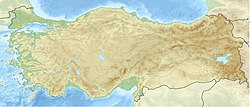Top Qs
Timeline
Chat
Perspective
2003 Bingöl earthquake
From Wikipedia, the free encyclopedia
Remove ads
An earthquake hit eastern Turkey with a moment magnitude of 6.4 and a maximum Mercalli intensity of IX (Violent) on 1 May 2003 at 03:27 local time. The epicenter of this strike-slip earthquake was in Bingöl Province, 15 km north of the city of Bingöl. At least 177 people were killed and 3,305 buildings collapsed or suffered heavy damage in the affected region. Eighty-four of the fatalities occurred when a dormitory block collapsed in a boarding school in Celtiksuyu.[5]
Remove ads
Tectonic setting
Most of Turkey lies on the Anatolian Plate, which is being forced westwards by the collision between the Arabian plate and the Eurasian plate. This westward movement is accommodated by two large strike-slip fault zones, the west–east trending right lateral North Anatolian Fault in the north of the country and the SW-NE trending left lateral East Anatolian Fault towards the south-east. Movement on these two faults have been responsible for many large and damaging earthquakes historically.[6]
Remove ads
Earthquake
The earthquake occurred on May 1, 2003, with a depth of 15 km (9.3 mi).[7] It was a strike-slip event, lasting about 17 seconds with a magnitude of 6.4. It occurred at 3:27 am local time.[8] The strike-slip fault responsible was not the East Anatolian Fault; it ruptured a right-lateral strike-slip fault perpendicular to the East Anatolian Fault.[9]
Numerous seismically induced ground deformations, displacements and ruptures were observed in the epicentral area. According to these observations, a few surface ruptures were located between the villages of Hanoçayırı and Sudüğünü, with a vertical drop of 40–65 cm (1.31–2.13 ft) observed at a nearby field.[4] By 8 May, there were over 6,700 aftershocks, including 1,962 on the day of the mainshock.[4]
Remove ads
Damage

The earthquake damaged hundreds of buildings made of reinforced concrete and masonry. Many school buildings constructed within the last six years were heavily damaged.[10] A total of 177 people were killed;[1] 84 of the fatalities occurred when a dormitory block collapsed in a boarding school.[11] A total 8,417 houses being damaged, of which 305 collapsed, 3,000 heavily damaged, 2,566 moderately damaged, and 2,546 slightly damaged.[8] In the city of Bingöl, 6,570 buildings were damaged, 570 of them seriously,[4] including 90% of schools, four of which collapsed; the school where the dormitory block collapsed was a 5-story building. Three hospitals in the city were also damaged.[8] The majority of destroyed or seriously damaged buildings were constructed using unreinforced concrete, which are prone to collapsing in strong tremors.[4]
International search and rescue response
Offers of Assistance
Greece offered search and rescue assistance, but the Turkish government declined, citing that the scale of destruction was manageable with national resources. Turkey did not request or accept foreign SAR teams for the emergency phase.[12]
International Readiness
Teams from Austria, Britain, Germany, Greece, Italy, France, Norway, and other countries were on standby and available, but their assistance was not requested by Turkey.[12]
International red cross and red crescent
The International Federation of Red Cross and Red Crescent Societies (IFRC) sent a psychosocial delegate and a professional to support the Turkish Red Crescent’s psychosocial team. The American Red Cross contributed 14,000 kitchen utensils for victims.[12]
Financial and Material Support
The IFRC called for member donations of 2,384,000 Swiss francs (about US$1.77 million) to assist emergency relief operations in Bingöl.[12]
Remove ads
See also
References
Further reading
External links
Wikiwand - on
Seamless Wikipedia browsing. On steroids.
Remove ads
